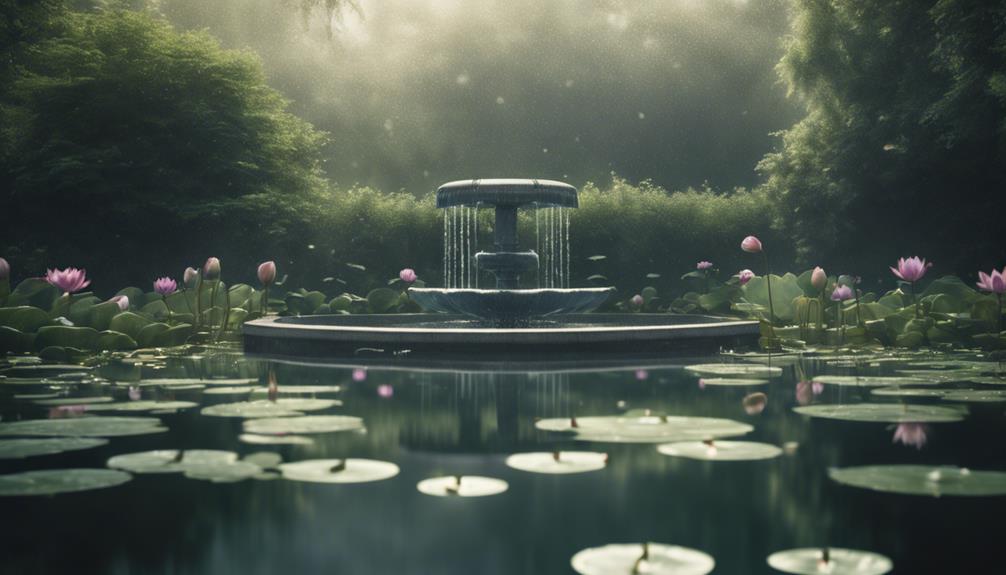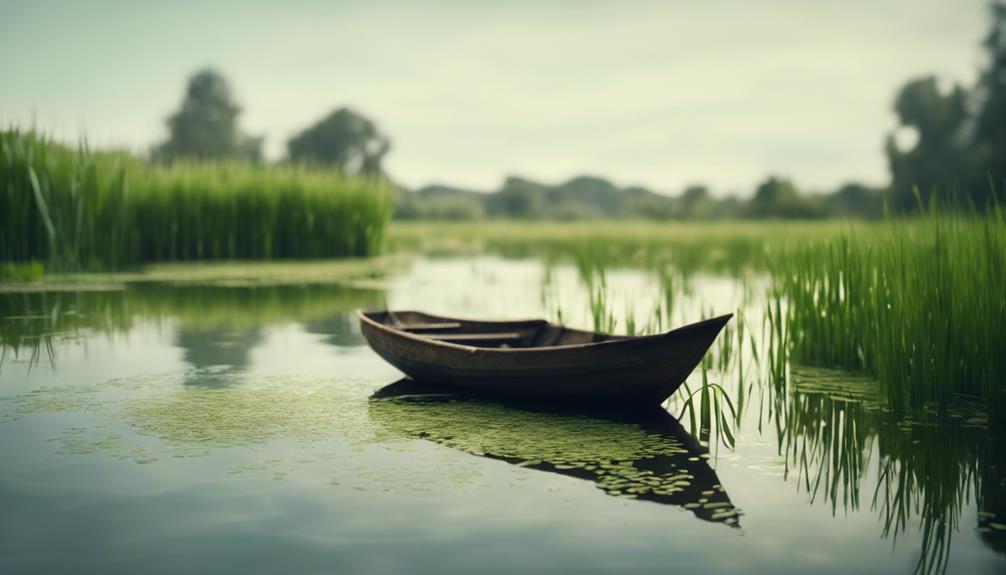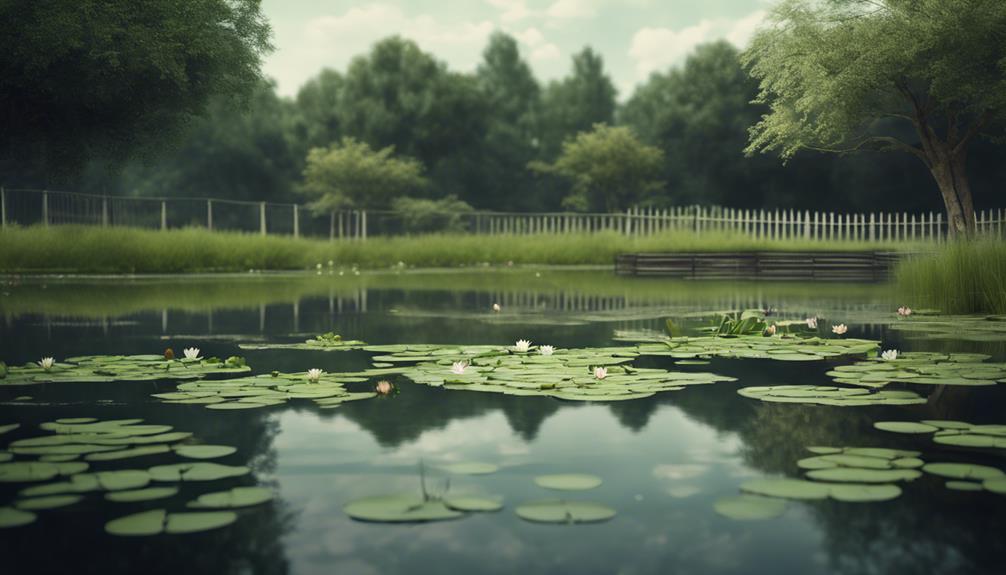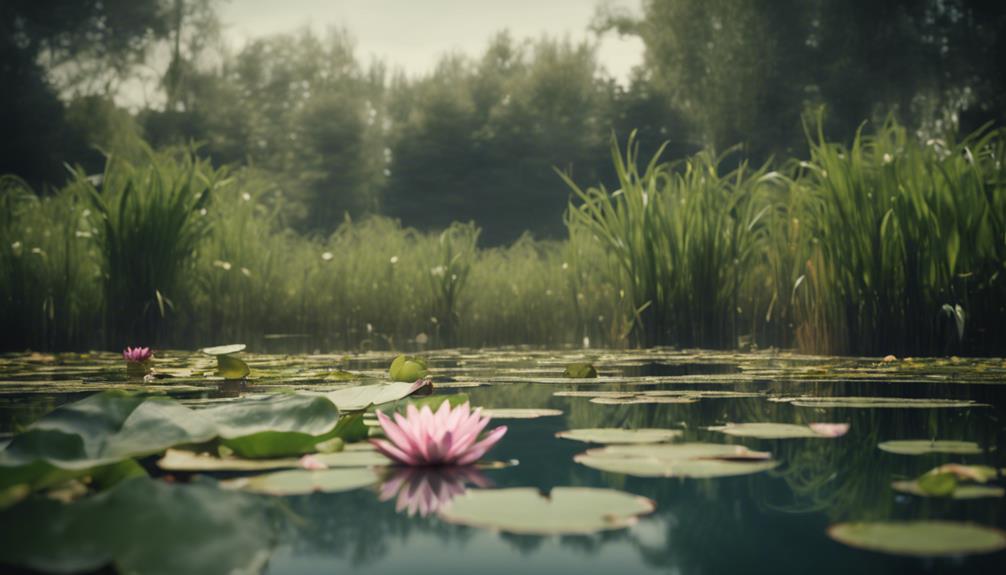You can effectively stop pond algae growth using a combination of natural methods that work harmoniously to create a balanced ecosystem. Manual removal, aquatic plants, aeration, beneficial organisms, barley straw, algae-eating fish and snails, limiting nutrient sources, and ongoing pond maintenance all play a vital role in controlling algae growth. By incorporating these methods, you'll be able to maintain a thriving pond environment that discourages algae growth. As you explore these natural methods further, you'll discover the intricate relationships between them and how they work together to create a healthy, algae-free pond.
Table of Contents
Key Takeaways
- Incorporating 20-30% of aquatic plants in the pond can effectively reduce algae growth by absorbing excess nutrients and shading the water.
- Aeration methods like waterfalls, fountains, and air stones increase oxygen levels, reducing stagnation and algae growth.
- Beneficial bacteria break down organic matter, consuming excess nutrients that would otherwise fuel algae growth, and can be added to the water to boost natural populations.
- Barley straw is a natural, non-toxic method to control algae growth by releasing compounds that inhibit algae growth.
- Introducing algae-eating fish and snails, like grass carp and Nerite snails, can provide a natural way to reduce algae populations in the pond.
Natural Algae Control Methods
You can harness the power of Mother Nature to combat pond algae growth by introducing natural algae control methods that work in harmony with your ecosystem.
By naturally controlling algae, you're not only creating a balanced environment but also promoting a thriving aquatic community.
One effective method is manual removal, where you physically remove excess algae from the pond surface.
This approach is most effective when combined with other natural methods.
For instance, introducing aquatic plants like oxygenating plants can help reduce algae growth by absorbing excess nutrients.
Barley straw is another natural solution that inhibits algae growth by releasing compounds that prevent algae from forming.
By incorporating these natural algae control methods, you're preventing algae from taking over your pond.
Remember, a balanced ecosystem is key to maintaining a healthy pond.
Using Plants to Stop Algae
Incorporating approximately 20-30% of aquatic plants in your pond can effectively reduce algae growth by absorbing excess nutrients and shading the water.
You can choose from a variety of plants, including submerged plants, marginal plants, and Water lilies.
Submerged plants, such as hornwort and cabomba, absorb nutrients from the water, depriving algae of the fuel it needs to grow.
Marginal plants, like cattails and irises, help to shade the water and reduce algae growth.
Water lilies, with their large leaves, provide additional shade and reduce the amount of light available for algae growth.
The relationship between plants and algae is complex, but vitally, plants consume algae as a source of nutrients.
In return, plants and bacteria work together to maintain an ecological balance in your pond.
By introducing these beneficial plants, you'll create a natural harmony that reduces the need for algae-control measures.
Remember, a balanced ecosystem is key to maintaining a healthy, algae-free pond.
Aeration for Algae Prevention

A well-aerated pond serves as a crucial component in the prevention of algae growth, as it fosters an environment that promotes the health and proliferation of beneficial aerobic bacteria. These microorganisms break down organic matter, consuming excess nutrients that would otherwise fuel algae growth. By introducing oxygen into the water, aeration stimulates the natural decomposition process, reducing the accumulation of organic matter that fuels algae growth.
| Aeration Method | Effect on Algae Growth |
|---|---|
| Waterfalls | Increases oxygen levels, reducing stagnation and algae growth |
| Fountains | Introduces oxygen, supporting beneficial bacteria and discouraging algae |
| Air Stones | Boosts oxygen levels, promoting healthy aerobic bacteria populations |
| Windmills | Reduces stagnation, encouraging oxygen-rich environments and limiting algae growth |
| Proper Aeration | Prevents uneven nutrient and oxygen distribution, reducing ideal conditions for algae growth |
Beneficial Bacteria in Ponds
Maintaining a thriving population of beneficial bacteria in your pond is essential for preventing algae growth, as these microorganisms play a pivotal role in breaking down organic matter and consuming excess nutrients.
By doing so, they reduce the availability of resources for algae growth, helping to maintain a balanced ecosystem.
Aerobic bacteria, which thrive in oxygen-rich environments, are particularly effective at consuming nutrients and reducing algae growth, making aeration systems a valuable tool in pond maintenance.
You can introduce beneficial bacteria to your pond through commercial bacterial cultures, which can be added to the water to boost natural populations and enhance their effectiveness.
These microorganisms also play a vital role in the nitrogen cycle, converting ammonia and nitrite into harmless nitrogen gas, which helps to reduce the toxicity of the pond environment and prevent algae growth.
To guarantee their success, regularly monitor your pond's water conditions, including pH, ammonia, and nitrite levels, to create a favorable environment for beneficial bacteria to thrive and effectively control algae growth.
Barley Straw Algae Solution

You can complement your beneficial bacteria population with a natural, non-toxic method to control algae growth by introducing barley straw into your pond ecosystem. This environmentally friendly approach is a great way to prevent algae in ponds.
When barley straw decomposes, it releases compounds that inhibit algae growth, providing a gradual and long-lasting control method.
Place the barley straw in a mesh bag and anchor it where water flows over it for optimum results.
The decomposition process takes several weeks, after which it starts to inhibit algae growth.
The exact mechanism of how barley straw inhibits algae growth is still unknown, but it's believed to involve the release of lignin, a complex organic compound.
Algae-Eating Fish and Snails
Certain species of fish, like the grass carp, and snails, such as Nerite snails, can be introduced to your pond as a natural and effective means of controlling algae growth.
These algae-eating fish and snails feed on algae, providing a natural way to reduce algae populations in your pond. Grass carp, for instance, can consume up to 3% of their body weight in algae per day, making them a valuable asset in pond algae management.
When introducing these algae-eaters to your pond, it's crucial to do so mindfully, as they may also consume other aquatic plants. Verify they're compatible with other pond inhabitants to maintain a balanced ecosystem.
Using algae-eating fish and snails in conjunction with other natural methods, such as aeration, beneficial bacteria, and aquatic plants, can create a thriving pond environment. By incorporating these natural methods, you can stop pond algae growth and maintain a healthy, algae-free pond.
Limiting Nutrient Sources

By controlling the amount of nutrients that enter your pond, you can prevent excess algae growth and create a balanced ecosystem. Excess nutrients in your pond can lead to an overgrowth of algae, which can harm the environment and affect the overall health of your pond.
Avoid allowing grass clippings, leaves, fertilizer, and other nutrient-loaded organic debris to enter the waterbody, as they can contribute to excess nutrient levels.
Limit mowing around the edges of lakes or ponds to help establish a protective vegetative buffer that absorbs excess nutrients, reducing the likelihood of algae growth.
Plant beneficial vegetation in and around the edges of lakes or ponds to stabilize the bank, help reduce erosion areas, and keep nutrients from entering the waterbody, thereby controlling algae growth.
Ongoing Pond Maintenance
Implementing a regular maintenance routine is crucial to sustaining a balanced pond ecosystem, as it enables proactive measures to prevent algae growth and guarantees the effectiveness of natural methods.
By establishing an annual program focused on water quality improvements, you'll be well on your way to maintaining a healthy pond. This includes limiting excess nutrients from entering the water, which can be achieved by avoiding grass clippings, leaves, and fertilizer from getting into the pond. You can also establish a protective vegetative buffer around the pond to reduce erosion and keep nutrients out.
Installing aeration systems is another key aspect of ongoing maintenance, as they increase diffused oxygen in the water, supporting beneficial aerobic bacteria that break down organic matter and consume excess nutrients.
Regular monitoring is essential to confirm the effectiveness of these natural methods and make adjustments as needed. By staying on top of your pond's maintenance, you'll be able to prevent algae growth and enjoy a thriving ecosystem.
Frequently Asked Questions
How to Naturally Prevent Algae in a Pond?
To naturally prevent algae in your pond, you'll want to focus on maintaining an aquatic balance through pond aeration and water circulation, introducing beneficial bacteria, and promoting ecosystem maintenance, while also considering pond shading and algae predators.
How to Get Rid of Green Water in a Pond Naturally?
As you navigate the murky waters of your pond, imagine a conductor leading an orchestra to harmony. To eliminate green water, you'll need to fine-tune water quality by reducing algae blooms, boosting oxygen levels, and introducing nitrogen fixers, beneficial bacteria, and pond aeration, while removing sediment.
What Plants Reduce Algae in Ponds?
You'll find that Water Lilies, Algae Fighters, and other Aquatic Plants act as Natural Filters, Pond Balancers, and Oxygen Boosters, providing eco-friendly solutions to reduce algae growth, creating a harmonious ecosystem where you can thrive together with nature.
Does Vinegar Stop Algae Growth?
You think vinegar's a magic bullet for algae, but it's not that simple. Vinegar's acetic acid can help prevent algae growth by lowering pH levels, but it's a delicate balance – too much can harm your pond's ecosystem, and its benefits are short-lived.
Conclusion
Stopping pond algae growth requires a multi-faceted approach. It's like taming a wild garden – you need to prune, water, and nurture the right elements to create a balanced ecosystem.
By implementing these natural methods, you'll be well on your way to a thriving pond.
For example, did you know that a single pond with 10,000 gallons of water can produce up to 70 pounds of algae per year?
By using these methods, you can substantially reduce that amount, creating a clearer and healthier pond environment.

